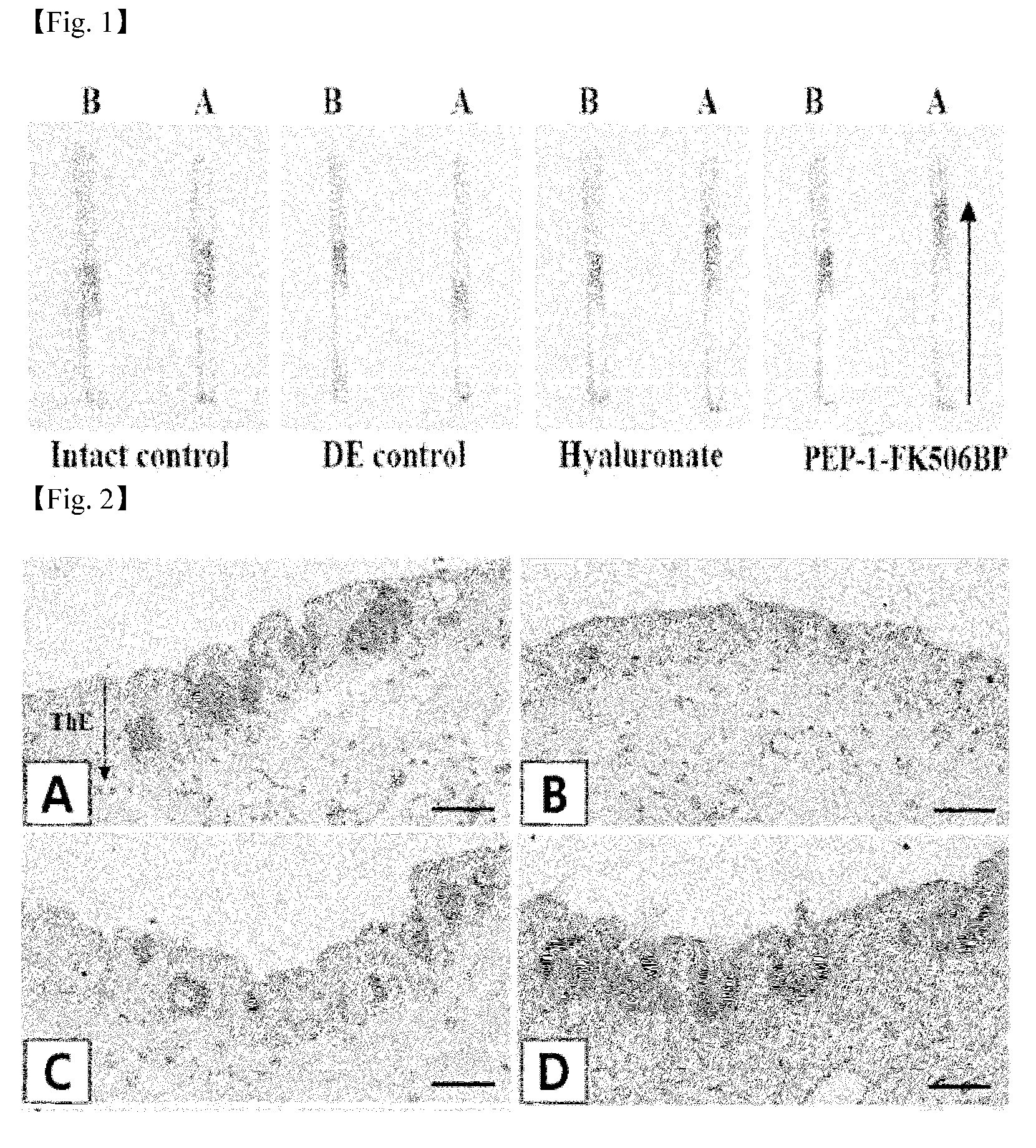Eye drop composition for prevention and treatment of ophthalmic diseases containing fusion protein of fk506 binding protein
a technology of fusion protein and eye drop, which is applied in the field of pharmaceutical composition for the treatment of ophthalmic diseases, can solve the problems of delayed wound healing, increased intraocular pressure, adverse effects, etc., and achieves the effects of increasing the thickness of the conjunctival epithelium, increasing the secretion of tears, and increasing the production of mucus
- Summary
- Abstract
- Description
- Claims
- Application Information
AI Technical Summary
Benefits of technology
Problems solved by technology
Method used
Image
Examples
example 1
Construction and Transduction of PEP-1-FK506BP Fusion Protein Expression Vector
[0067]An expression vector for a fusion protein capable of transducing the functional target protein into the cell was constructed. Human FK506BP was selected as a target protein.
[0068]First, a pET-PEP expression vector containing PEP-1 peptide (KETWWE TWWTEW SQP KKKRKV, SEQ ID NO: 1) was constructed to produce the PEP-1-FK506BP fusion protein. Two kinds of oligonucleotides, corresponding to the PEP-1 peptide (top strand, 5′-TATGAAAGAAACCTGGTGGGAAACCTGGTGGACCGAATGGTCTCAGC CGAAAAAAAAACGTAAAGTGC-3′, SEQ ID NO: 15; bottom strand, 5′-TCGAGCACTTTACGTTTTTTTTTCGGCTGACACCATTCGGTCCACCAGG TTTCCCACCAGGTTTCTTTCC-3′, SEQ ID NO: 16) were ligated into NdeI-Xho I-digested pET-15b vector. Next, two oligonucleotides were synthesized based on the cDNA sequence of human FK506BP. The forward primer 5′-CTCGAGATGGGAGTGC AGGTGGAAACCATC-3′ (SEQ ID NO: 17) contained a Xho I restriction site, and the reverse primer 5′-GGATCCTCATTCC...
example 2
Expression and Purification of PEP-1-FK506BP Fusion Protein
[0071]E. coli BL21 (DE3) cells transformed with the cDNA of human FK506BP using the PEP-1-FK506BP prepared in Example 1 were inoculated to LB medium containing ampicillin and cultured at 37° C. while stirring at 200 rpm. When the bacterial concentration (OD600) in the culture medium reached 0.5-1.0, IPTG was added to the medium to a final concentration of 0.5 and 1 mM, and then the cells were further cultured for 12 hours at 30° C. The cells were harvested by centrifugation and then ultrasonicated in 5 mL of binding buffer (5 mM imidazole, 0.5 M NaCl, 20 mM Tris-HCl, pH 7.9). After centrifugation, the supernatant was immediately loaded onto a Ni2+-nitrilotriacetic acid sepharose superflow column. After washing with 10 times the volume of binding buffer and 6 times the volume of washing buffer (60 mM imidazole, 0.5 M NaCl, 20 mM Tris-HCl, pH 7.9), the fusion protein was eluted with an elution buffer (1 M imidazole, 0.5 M NaCl...
example 3
Construction and Transduction of Tat-FK506BP Fusion Protein Expression Vector
[0074]To overexpress a Tat-FK506BP fusion protein, the pET-Tat-FK506BP expression vector containing consecutive cDNA sequences encoding FK506BP, the HIV-1 Tat transduction domain (Tat 49-57) and six histidines was constructed. First, the pET-Tat expression vector having the basic domain of HIV-1 Tat (amino acids 49-57) was constructed. Two kinds of oligonucleotides, corresponding to the basic domain of Tat (top strand, 5′-TAGGAAGAAGCGGAGACAGCGACGAAGAC-3′, SEQ ID NO: 19; bottom strand, 5′-TCGAGTCTTCGTCGCTGTCTCCGCTTCTTCC-3′, SEQ ID NO: 20) were ligated into NdeI-Xho I-digested pET-15b vector. Next, two oligonucleotides were synthesized based on the cDNA sequence of human FK506BP. The forward primer (SEQ ID NO: 17) contained the Xho I restriction site, and the reverse primer (SEQ ID NO: 18) contained the Bam HI restriction site.
[0075]PCR was performed in a thermocycler (Perkin-Elmer, model 9600). The reaction ...
PUM
| Property | Measurement | Unit |
|---|---|---|
| humidity | aaaaa | aaaaa |
| area | aaaaa | aaaaa |
| pH | aaaaa | aaaaa |
Abstract
Description
Claims
Application Information
 Login to View More
Login to View More - R&D
- Intellectual Property
- Life Sciences
- Materials
- Tech Scout
- Unparalleled Data Quality
- Higher Quality Content
- 60% Fewer Hallucinations
Browse by: Latest US Patents, China's latest patents, Technical Efficacy Thesaurus, Application Domain, Technology Topic, Popular Technical Reports.
© 2025 PatSnap. All rights reserved.Legal|Privacy policy|Modern Slavery Act Transparency Statement|Sitemap|About US| Contact US: help@patsnap.com


